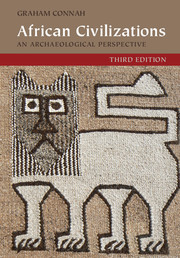Book contents
- Frontmatter
- Dedication
- Contents
- List of figures
- Preface and acknowledgements
- 1 The context
- 2 Origins: social change on the lower Nile
- 3 The Mediterranean frontier: North Africa
- 4 Sudanic genesis: Nubia
- 5 Isolation: the Ethiopian and Eritrean Highlands
- 6 Opportunity and constraint: the West African savanna
- 7 Achieving power: the West African forest and its fringes
- 8 Indian Ocean networks: the East African coast and islands
- 9 Cattle, ivory, and gold: social complexity in Zambezia
- 10 Central Africa: the Upemba Depression, Interlacustrine Region, and Far West
- 11 Settlement growth and emerging polities: South Africa
- 12 What are the common denominators?
- References
- Index
5 - Isolation: the Ethiopian and Eritrean Highlands
Published online by Cambridge University Press: 05 November 2015
- Frontmatter
- Dedication
- Contents
- List of figures
- Preface and acknowledgements
- 1 The context
- 2 Origins: social change on the lower Nile
- 3 The Mediterranean frontier: North Africa
- 4 Sudanic genesis: Nubia
- 5 Isolation: the Ethiopian and Eritrean Highlands
- 6 Opportunity and constraint: the West African savanna
- 7 Achieving power: the West African forest and its fringes
- 8 Indian Ocean networks: the East African coast and islands
- 9 Cattle, ivory, and gold: social complexity in Zambezia
- 10 Central Africa: the Upemba Depression, Interlacustrine Region, and Far West
- 11 Settlement growth and emerging polities: South Africa
- 12 What are the common denominators?
- References
- Index
Summary
For many observers it has been the isolation of this region, particularly that of the central highlands of Ethiopia and Eritrea, that has made the greatest impression. The core of the region is a great block of mountains, everywhere more than 1,000 metres in height, that reaches a general level of 2,300 metres and in places exceeds 4,200 metres above sea level. One could not imagine a less likely setting for state emergence and urbanization. Nevertheless, in the modern countries of Ethiopia and Eritrea there is evidence for such developments during the first few centuries AD, and indications of their origins during the first millennium BC (D.W. Phillipson 2009a; 2009c; 2012). Not only are these dates early for the attainment of social complexity in tropical Africa, but these achievements were highly sophisticated. Almost 2,000 years ago, the state of Aksum boasted urban centres; its own form of writing; coinage in gold, silver, and bronze; masonry buildings of a distinctive architectural style; unique monuments that indicate quarrying and engineering skills; extensive trading contacts both within and outside Africa; and a significant role in international politics. Indeed, Aksum seems to have been one of the first states to adopt Christianity (D.W. Phillipson 1998: 145 note 1). However, the antecedents of Aksumite culture can be discerned as early as the eighth century BC in the period formerly known as the Pre-Aksumite. Large settlements existed at Yeha, in Ethiopia, and at Matara and Sembel, in Eritrea, the last one of these belonging to the possibly earlier Ona Culture (Schmidt and Curtis 2001; Schmidt et al. 2008; Curtis 2009; Fattovich 2009; Schmidt 2009). In some places inscriptions appeared and there was sophisticated stone masonry, sculpture, and metallurgy, although stone artefacts were also still used. Furthermore, there were contacts with South Arabia and to a lesser extent with the Nile Valley. Far from being isolated, Ethiopia and Eritrea appear to have formed, at times, an important zone for cultural integration. For Edward Ullendorff (1960: 23) the region was ‘a bridge between Africa and Asia’.
- Type
- Chapter
- Information
- African CivilizationsAn Archaeological Perspective, pp. 111 - 148Publisher: Cambridge University PressPrint publication year: 2015



